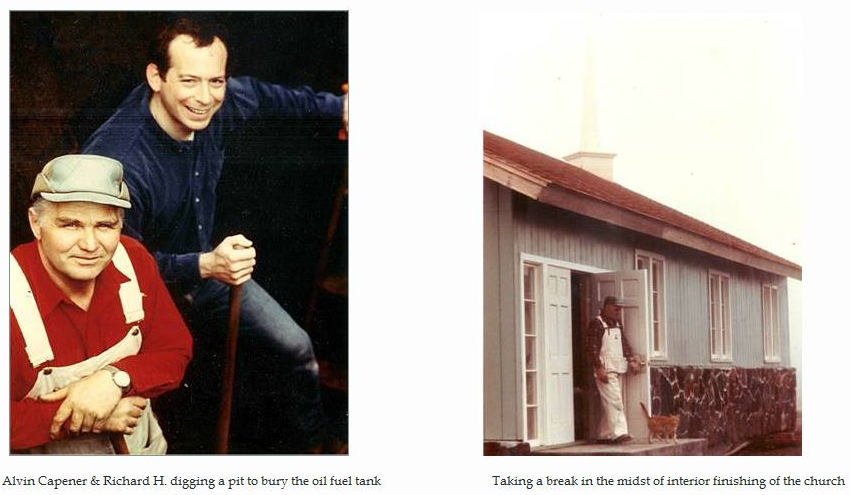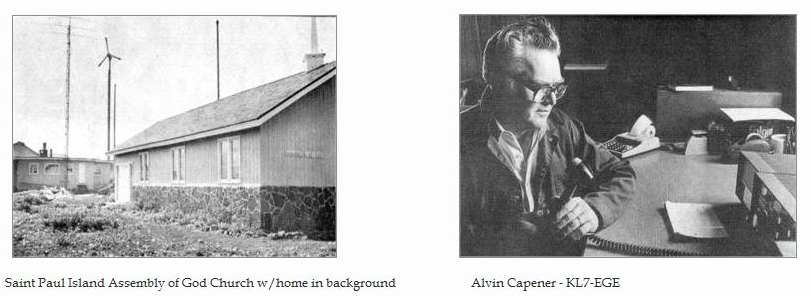
ANOTHER COFFEE BREAK: 40 YEARS BELOW ZERO, Part 22
April
29, 2016
Let's get right back to our ongoing adventure and pick up where
we left off last week.

The young school teacher, Richard (pictured above with shovel in hand), was typical of the young men who made it their business to come around as often as possible and help out in the various tasks Dad & Mom had on hand to make things more efficient. The smile on Richard's face is the smile of a young man overjoyed at coming to know the Lord Jesus Christ personally. In the photo, they were digging a pit beside the church in order to bury a 250-gallon tank for fuel oil for heating both the church and the home. Fuel oil was brought in by barge, pumped into drums or tanks and then hauled throughout the community distributing as folks needed (and had pre-ordered).
In our last Coffee Break, I made mention of the rock wall or wainscoting that bordered the lower portion of the church at Saint Paul Island. In the photo to the right above, that rock work is very evident. The photo below (taken by Barbara Krizman of the Anchorage Daily News) shows the church and the home, along with Dad's radio towers and wind generator (more on this in a moment).

Electricity on the island was an expensive commodity -- not unlike it was in Barrow where we paid .42/KWH. At 42 cents for every thousand watts of electricity consumed, it was not uncommon to see electric bills of $600 - $1,000 every month. Dad was in every way a conservationist. Despite every effort to conserve power in the most diligent manner, he rarely saw an electric bill of less than $400. The island had a huge diesel generator which it used to supply power to the homes, but with the cost of imported fuel and maintenance to that generator, the community did well to break even with its costs of operation -- even charging ever-increasing rates for electricity.
In 1978, while I was in Barrow, I came across an opportunity to purchase wind generators for a fairly reasonable price. An electrician friend in Barrow was the first one to purchase one of these 3500 watt wind generators and install it at his home. Despite a price tag of roughly $12,500 shipped in and installed, the generator paid for itself the first year -- and Barrow has a fraction of the winds Saint Paul enjoys.
In a conversation with my father one day on the telephone, we were talking about his high costs of electricity and I mentioned the savings my electrician friend was seeing (and his had only been operational for about three months). Dad seized on the idea immediately and asked me to get one for him. About six weeks later, his generator was delivered.
Because the island has wind speeds pretty consistently in the 17 - 25 knot range, and is almost entirely made up of volcanic material, the wind carries scoria (volcanic ash and dust particles). It has the effect of sandpaper on just about everything. Metal deteriorates rapidly when exposed unless constantly treated with a highly-resistant paint on a regular basis. Steel or aluminum towers can disintegrate and topple within three to five years unless they are constantly treated.
Dad was already experiencing problems with his main radio tower, and he had used a couple of 60 or 70-foot telephone poles to string his "inverted vee" antennas because they easily outlasted the aluminum. He decided to construct a 50-foot tower for the wind generator out of 2x12 lumber and laminate it with fiberglass. With a built-in ladder and easily removable work platform at the top, it made installation of the wind generator simple, and easy to maintain.
He wired the generator in such a way that when the wind blew and he wasn't using the entire output of the generator -- which was most of the time -- it ran the electric meter from the city backward. That first year of operation, the generator not only paid for itself, his electricity was free; and at the end of the year, he got back some $400 from the city. They paid him the going rate for all of the excess electricity he furnished to the city power grid.
It was in the winter of 1976-1977 that I was in the process of moving back to Alaska (from Long Beach, California) in order to bring CBN's operations and the ministry of the 700 Club to the state. CBN had authorized me to do this, but also advised me that they had no funds available to help me with the project. Dad and I were talking on the phone (Ham radio patch, of course) one day and he suggested that I should come to Saint Paul Island and trap foxes with him. Arctic Blue foxes abounded on the island, and the fur pelts they yielded were of premium quality. He had sold his furs at the Seattle Fur Exchange, bringing (in the previous years) anywhere from $35 to $50 per fox pelt.
Dad had been trying his hand at trapping during the previous two years with some good results. He suggested that if we worked together at it, we could likely bring in a good season and provide the necessary funds to get things started. Despite growing up in the arctic, I'd never trapped before but it sounded like a great way to generate some startup capital.
I arrived on Saint Paul Island in late August -- a bit early to begin the fox trapping season, but Dad wanted to expand the size of the house and add a garage to house the burgeoning motorcycle and three-wheeler business. That gave us a few weeks to pour a concrete foundation for the expansion and build the garage. The house was already "L" shaped, and the garage would fit nicely squaring the house. My previous assistance in building with Dad made it a breeze for us to work together since I knew exactly his building methodologies and techniques and were able to get the garage built, enclosed, insulated and prepped to house some 30 motorcycles, three-wheelers and the pickup truck.
By late September, we headed out across the island to locate the fox dens and begin setting out bait minus traps in order to establish places where the foxes would feed regularly. A week later we set out approximately 30 traps. Our first trip to check the traps yielded a dozen foxes or so. We found some additional places to set traps at the same time -- a process that increased every few days or so until we had more than 50 traps set out.
So long as there was no snow on the ground, getting the foxes was a pretty easy task. About three weeks into the trapping, however, a blizzard hit the island burying everything in some two feet of snow. You'd think that would make things more difficult, but the truth is that one develops a trapper's instinct, and finding the traps turned out to be a whole lot easier than I imagined.
Catching foxes involved a whole lot more than just taking them out of the traps and bringing dead foxes home. Each fox had to be skinned and the pelt treated with corn meal (it sounds strange, I know, but the corn meal removed the oils and blood from the bait the foxes had eaten), and then stretched out on a specially made rack to dry. Every day we brought home foxes from the traps meant our work wasn't done until the fox was skinned, the pelt treated and allowed to breathe prior to drying on a rack.
The trapping day began around 10:00 in the morning and generally ended around 11:00 PM or thereabouts depending on the number of pelts needing to be dealt with. Each pelt took approximately three days to prep for the drying racks. Those drying racks had to be anchored to the house roof top in order to prevent other animals from taking them.
Over a period of some six weeks to two months, we tramped the length and breadth of Saint Paul Island more times than I can count. Most of the time, we would take either a snow machine with a sled attached or Dad's pickup truck to haul the bait and bring back the foxes, and the snow machine or pickup (the choice of vehicle somewhat depended on the prevailing weather conditions) would be parked at some central location from which we could work.
In mid-January of 1977, we were caught in a blizzard that could have been deadly for both of us. There had been a fresh snowstorm the previous night, and the snow was quite dry and powdery. We'd been enjoying our trapping during the morning and retrieval of foxes from traps. We were working out on the far northeast end of the island near some cliffs that rise straight up from the water's edge some 90 - 120 feet when without warning the winds came up. Naturally, the sea was frozen over by this time of year, and jagged ice bergs lay at the bottom of the cliffs. The loose, powdery snow filled the air creating white-out conditions which totally obscured our vision. I couldn't see five feet in front of my face.
If I bent over, I could see tracks in the snow banks leading back towards the snow machine; and I began to retrace my steps. The snow was blowing so furiously that it soon filled in the old footprints leaving me completely directionless. I called out to Dad, but the wind prevented him from hearing me. He was calling me with the same result. We were probably not more than a hundred feet apart and had no clue where the other was.
I stopped totally still in my tracks knowing that if I got too far away from the original path I'd taken, going over the cliff was a very distinct possibility -- or more accurately, a real probability. I just stood there for a minute and prayed. "Father, I need direction. Which way do I head?"
The Holy Spirit quickly communicated a change in the way I was headed, and I just began walking...Ummm...trudging or wading through knee-deep and sometimes thigh-deep snow -- albeit completely blinded by the white-out. After about fifteen or twenty minutes of this, I suddenly found myself about ten feet from the snow machine. The winds began to subside so I hollered out for Dad.
He'd pretty much done what I'd done, and the Holy Spirit had likewise led him directly to the snow machine. I saw his form emerge from the diminishing white-out perhaps twenty or twenty-five feet away. The entire cliff area -- a major portion of our trapping area -- was still enveloped in white-out conditions, so we stopped our endeavor for the day and slowly traveled with the snow machine back towards town.
It wouldn't be the last time we would encounter such conditions, but we were better prepared the next time it happened. By the end of the first week of February, the main part of the trapping effort had ended and the time had come to finish prepping the fox pelts for shipment to Seattle and sale at the Fur Exchange.
When we began to actually count our furs -- the ones we shipped off to Seattle, anyway -- we had 208 Arctic Blues, 18 white foxes, and 4 large red fox pelts. The first of the fur auctions took place in March. When the fur buyers surveyed our Arctic Blues, the bidding quickly brought the price up, and those fox furs alone (not counting the whites and reds) brought an average of more than $50 per pelt. It was the highest price the Seattle Fur Auction had seen for Arctic Blue foxes in I don't know how long. After expenses and commissions paid to the Fur Exchange, we still netted more than $11,000 from the sale of all the furs.
That was the seed money that began CBN's ministry in Alaska -- seed that resulted in the salvation of more people than I can count or remember, never mind those who were healed, set free of demonic spirits, and filled with the Holy Spirit. Not too ironically, the television station at Saint Paul Island was the first station I was part of building, of all the stations we built to air television programming for the remote villages, and it was the first place to air the 700 Club in Alaska. Pretty appropriate, don't you think, considering that Saint Paul Island was the place from which those fox furs came?
Guess this is where we need to leave it for today.
I remind those of you in need of ministry that our Healing Prayer Call takes place on the first Monday of each month at 7:00 PM Eastern (4:00 PM Pacific). Our call-in number is (712) 775-7035. The Access Code is: 323859#. For Canadians who have difficulty getting in to this number, you can call (559) 546-1400. If someone answers and asks what your original call-in number was, you can give them the 712 number and access code.
At the same time, in case you are missing out on real fellowship in an environment of Ekklesia, our Sunday worship gatherings are available by conference call – usually at about 10:45AM Pacific. That conference number is (605) 562-3140, and the access code is 308640#. We hope to make these gatherings available by Skype or Talk Fusion before long. If you miss the live call, you can dial (605) 562-3149, enter the same access code and listen in later.
Blessings on you!

Regner A. Capener
CAPENER MINISTRIES
RIVER WORSHIP CENTER
Sunnyside, Washington 98944
Email Contact: Admin@RiverWorshipCenter.org
All Coffee Break articles are copyright by Regner A. Capener, but authorization for reprinting, reposting, copying or re-use, in whole or in part, is granted –provided proper attribution and this notice are included intact. Older Coffee Break archives are available at http://www.RegnersMorningCoffee.com. Coffee Break articles are normally published weekly.
If you would like to have these articles arrive each morning in your email, please send a blank email to: Subscribe@AnotherCoffeeBreak.com.To remove yourself from the mailing list, please send a blank email to Unsubscribe@AnotherCoffeeBreak.com.
CAPENER MINISTRIES is a tax-exempt church ministry. Should you desire to participate and covenant with us as partners in this ministry, please contact us at either of the above email or physical addresses, or visit: http://www.RiverWorshipCenter.org.
